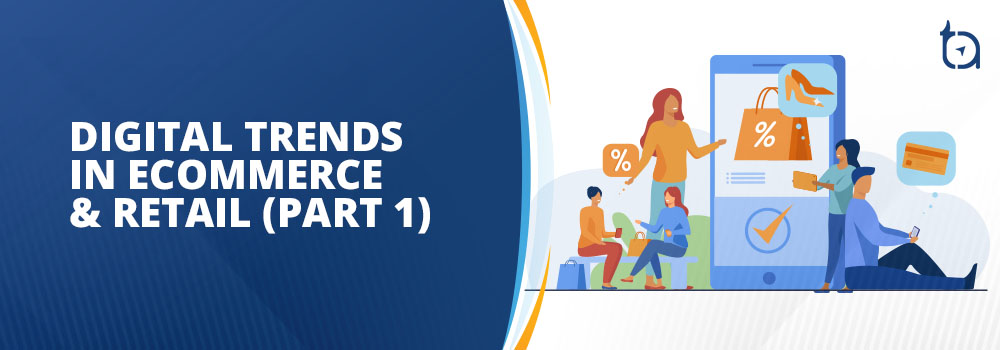Top Digital Trends Impacting the eCommerce & Retail Industries – Part 1

Author : Arul Selvan 27th Apr 2020

There are hundreds of thousands of retailers out there, and as the competition builds stronger, there comes a need to stand out of the competition and focus on improving the in-store customer experience. For this, there are a number of factors that influence customer experience, namely Virtual realityVirtual realityVirtual reality is a simulated experience that can be similar to or completely different from the real world. Applications of virtual reality can include entertainment and educational purposes. Other, distinct types of VR style technology include augmented reality and mixed reality., ChatbotChatbotA chatbot is a piece of software that conducts a conversation via auditory or textual methods. Such programs are often designed to convincingly simulate how a human would behave as a conversational partner., mobilemobilemobile phone or handphone, Is a portable telephone that can make and receive calls over a radio frequency link while the user is moving within a telephone service area., Big dataBig dataBig data is a field that treats ways to analyze, systematically extract information from, or otherwise, deal with data sets that are too large or complex to be dealt with by traditional data-processing application software., Voice SearchVoice SearchVoice Search or Search by Voice that allows users to search by speaking on a mobile phone or computer, i.e. have the device search for data upon entering information on what to search into the device by speaking., etc. These are the tools for retailers to focus on to improve their customer experience. Also, according to PYMNT research, VR is expected to generate $1.8 billion for retail and marketing in 2022. Let’s discuss the latest digital trends in eCommerce in the coming sections.
So, let’s get started with Virtual Reality (VR).
1.Virtual Reality
One of the biggest eCommerce trends of this decade is Virtual Reality helps both consumers and retailers in their approaches to selling and buying things. Also, Virtual realityVirtual realityVirtual reality is a simulated experience that can be similar to or completely different from the real world. Applications of virtual reality can include entertainment and educational purposes. Other, distinct types of VR style technology include augmented reality and mixed reality. is capable of changing the way people shop around and their relationships with brands. It leads to choosing a store over another to purchase a specific product.

Retailers are going a step ahead with this technology and better caters to future customer requirements. Retailers empower customers to look at the 360-degree view of themselves with their favorite clothes on and thus bring real-life experience to the shopping experience.
With VR, retailers can enable customers to be at their comfort at home instead of driving down to the storefront and offer a host of recommendations and purchase options to their digital world. A typical VR experience could enable showroom personnel to let their customers test drive their cars without taking out the car from the showroom. Also, even a headset can be chosen in a fashion that suits their living room or any other room of their choice.
Consumers like to try before paying their hard-earned money on any stuff, and virtual reality just does the same. It offers interactivity that leads to immersion. As a result, more visitors are converted into buyers.
2.Chatbots
Using chatbots, you can simulate real-life conversations with your visitors and help them navigate through your website. With chatbots, you can assist your visitors with what they want 24×7 and this is an emerging eCommerce trend.

With the help of machine learning, AI, and deep learning, you can figure out the intent of your visitor and address their needs. Also, deep processing power improves the quality of decision making. Moreover, it allows chatbots to understand and address the customer queries to the point and learn from the interactions.
Your prospective customer might have questions to ask, clarify doubts, and wish to have someone by their side for guidance and recommendations. Hence, the conversation with your chatbot increases the chances of a sale.
3. Voice Search
The world is witnessing the rise of voice assistants majorly used for shopping activities. Microsoft CortanaMicrosoft CortanaCortana is a virtual assistant created by Microsoft for Windows 10, Windows 10 Mobile, Windows Phone 8.1, Invoke smart speaker, Microsoft Band, Surface Headphones, Xbox One, iOS, Android, Windows Mixed Reality, and Amazon Alexa., Google AssistantGoogle AssistantGoogle Assistant is an artificial intelligence-powered virtual assistant developed by Google that is primarily available on mobile and smart home devices., Amazon AlexaAmazon AlexaAmazon Alexa is a virtual assistant AI technology developed by Amazon, first used in the Amazon Echo smart speakers developed by Amazon Lab126. It is capable of voice interaction, music playback, making to-do lists, setting alarms, streaming podcasts, playing audiobooks, and providing weather, traffic, sports, and other real-time information., and Apple SiriApple SiriSiri is a virtual assistant that is part of Apple Inc.'s iOS, iPadOS, watchOS, macOS, and tvOS operating systems. The assistant uses voice queries and a natural-language user interface to answer questions, make recommendations, and perform actions by delegating requests to a set of Internet services. are some of the voice assistants you should be focusing on. It is also predicted that voice-driven customer experience will have an impact on the sales.

Voice search is the initial introduction of machine learning and is an extension of the AI. It is designed in such a way to learn your habits and needs. Depending on your behavior and purchase pattern, it automatically suggests your staples or any other product you would have run out of stock. Hence, with Machine Learning enabled voice search, you can tweak the way customer relationship management is used and address your customer needs effectively.
So, the voice search engines help mobile applications improve the user experience and empathize well with the users. Also, the stabilized version includes accessibility, uniqueness, and easy integration. It has become a reality because of the voice command APIs and massive database. AI & Machine Learning has a long way to go, and the voice search is just a head start. Voice search as an eCommerce trend as just began and will continue to grow from here.
4. Mobile
Mobile devices are widely used as a major platform for digital content and communication. Retail and E-commercee-commercee-commerce is the activity of electronically buying or selling products on online services or over the Internet. domains are no exception to it. It has all become possible due to the surge in smartphone sales.

The boom in smartphone sales and the innovation that goes into making the smartphones even powerful with larger displays helps enhance the mCommerce experience. On the other hand, the retailers who ventured their online store are optimizing their eCommerce store for mobile shopping. As a result, smartphones can now be used not only for product search and discovery, but also for comparisons, recommendations, and payments.
Loyalty program based campaigns increase interactivity and engagement when compared to traditional programs. According to a study by HubSpot, 37% of customers are willing to pay a fee for an enhanced tier of membership in their loyalty programs, and 70% say they are more likely to recommend brands with good loyalty programs.
Mobile platforms are exceptionally good when the location is enabled, as they can be used to offer rewards in real-time. Also, mobile advertising is an inevitable player in the digital advertising space.
5. Artificial Intelligence
Artificial IntelligenceArtificial IntelligenceArtificial Intelligence, sometimes called machine intelligence, is intelligence demonstrated by machines, in contrast to the natural intelligence was once considered to be a tool to drive attention to public places like restaurants, malls with the help of small programs that run a robot. It was also used to take care of household chores and industrial automation in factories.

The number of digital transactions across eCommerce businesses emphasizes the quick adoption of AI-powered technologies to stay ahead of the competition. Currently, leading businesses are leveraging AI to enhance online marketing, conversion rates, and brand recognition. Recently, leading tech companies such as Amazon, Facebook, eBay, and IBM publicly announced their embracing of AI.
There are a host of new ways through which AI can transform online sellers and B2B companies across the eCommerce industry. Enlisted below are a few ways in which Machine Learning & AI help eCommerce businesses improve sales and boost revenue.
- Chatbots
- Ubiquitous Personalization
- Data Analytics
- Marketing Campaigns
- Fraud Detection
- Accurate Product Recommendations
6. On-site Personalization
As said earlier, AI is making a significant change in the eCommerce world, and several eCommerce apps are now powered with AI. One of the examples where AI can be of utmost use is, gathering information about visitors and adjusting the eCommerce website according to their needs. Your customers value the products and the experiences that are tailor-made for them. You can ensure those things in your eCommerce store.

When brands harness the power of data, they can create relevant experiences for their visitors, which can be perceived as a tailor-made solution. Hence, personalization begins with collecting data and making the most out of them to make more informed decisions. Below are some of the data points you need to boost the personalization factor of your eCommerce website.
- Traffic.
- On-site interactions (category and product page visits).
- Email.
- Personal Data.
- Paid Media Pixels (both social and search).
- Purchases.
- Search.
- Pricing.
At TechAffinity, we have mastered the art of creating a high-end and seamless eCommerce experience for our clients, partners, and customers. Please line up your queries and email them to media@techaffinity.com. You can also schedule a meeting with our experts to discuss your requirements in detail.
